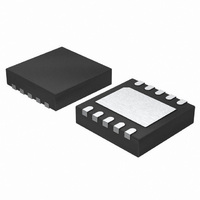ISL9214IRZ Intersil, ISL9214IRZ Datasheet - Page 8

ISL9214IRZ
Manufacturer Part Number
ISL9214IRZ
Description
IC CHRGR LI-ION/LI SGL 10-DFN
Manufacturer
Intersil
Datasheet
1.ISL9214IRZ.pdf
(11 pages)
Specifications of ISL9214IRZ
Function
Charge Management
Battery Type
Lithium-Ion (Li-Ion), Lithium-Polymer (Li-Pol)
Voltage - Supply
4.3 V ~ 24 V
Operating Temperature
-40°C ~ 85°C
Mounting Type
Surface Mount
Package / Case
10-VFDFN Exposed Pad
Lead Free Status / RoHS Status
Lead free / RoHS Compliant
Available stocks
Company
Part Number
Manufacturer
Quantity
Price
Company:
Part Number:
ISL9214IRZ
Manufacturer:
Intersil
Quantity:
50
Part Number:
ISL9214IRZ
Manufacturer:
INTERSIL
Quantity:
20 000
Company:
Part Number:
ISL9214IRZ-T
Manufacturer:
ROHM
Quantity:
5 523
The second function of the ICDL pin is to monitor the actual
charge current. The voltage of this pin, V
to the actual charge current, I
The cradle charge current should be programmed equal or
higher than the USB current; otherwise, the ICDL pin voltage
will be higher than 1.22V during the constant current mode
when the USB charger is working. The charger still works
properly but the accuracy of the current monitoring voltage
degrades and saturates at approximately 2.1V.
BAT (Pin 10)
Charger output pin. Connect this pin to the battery pack or
the battery cell. A 1µF or larger value ceramic capacitor is
recommended for decoupling. The charger relies on the
battery for stability so a battery should always be connected
to the BAT pin.
Description
The ISL9214 is designed for a single-cell Li-ion or Li-polymer
battery charging circuit that accepts both a USB port and a
desktop cradle as its power source. While the charge current
from the USB input source is fixed at 380mA, the charge
current from the cradle input is programmable between 0.1A
and 1.0A by the resistor R
current is programmable by connecting a resistor at the IMIN
pin. The end-of-charge threshold can be calculated with the
equation given on the Functional Pin Description section. The
same threshold applies to both the cradle and the USB inputs.
Input Auto Selection
When both input sources are present, the charger selects
only one power source to charge the battery. When the
CRDL input is higher than the POR threshold, CRDL is
selected as the power source. Otherwise the USB input is
selected. If the CRDL input voltage is below the battery
voltage but the USB input voltage is higher than the battery
voltage, then the USB input is used to charge the battery.
The control circuit always breaks both internal power
devices before switching from one power source to the other
to avoid a cross conduction of both power MOSFETs.
USB Charge Current
When the USB port is selected as the power source, the
charge current enabled by the logic input at the USBON pin.
When the USBON is driven to logic LOW, the charger is
disabled. When the USBON is driven to logic HIGH, the
charge current is fixed at a typical value of 380mA. Thus for
the USB input, the USBON pin has a similar function as the
EN pin. The following table describes the USB charge
control by both the USBON pin and EN pin:
USBON = LOW
USBON = HIGH
TABLE 1. USB CHARGE CONTROL
Disabled
Enabled
ICDL
EN = LOW
CHG
8
. Similarly, the end-of-charge
.
ICDL
Disabled
Disabled
, is proportional
EN = HIGH
ISL9214
The USBON pin is equivalent to a logic LOW when left
floating. Typically the P-channel MOSFET for the USB input
has an r
380mA charge current, the typical head room is 228mV.
Thus, if the input voltage drops to a level that the voltage
difference between the USB pin and the BAT pin is less than
228mV, the r
current; and the charger drops out the constant current
regulation.
Cradle Charge Current
The cradle charge current is enabled by the EN pin only, the
USBON pin has no control on the cradle charge current. The
cradle charge current is programmed with the external
resistor connected between the ICDL pin and the GND pin.
The current can be calculated with the equation given in the
ICDL pin description. The typical r
MOSFET for the CRDL input is 600mΩ at room temperature.
When the head room between the input and output voltages
is small, the actual charge current, similar to the USB case,
could be limited by the r
head room between the input and output voltages is large,
the charge current may be limited by the thermal foldback
threshold.
Floating Charge Voltage
The floating voltage during the constant voltage phase is
4.2V. The floating voltage has an 1% accuracy over the
ambient temperature range of -40°C to +85°C.
Trickle Charge Current
When the battery voltage is below the minimum battery
voltage V
operates in a trickle/preconditioning mode, where the charge
current is typically 18% of the programmed charge current
for the cradle input. If power comes from the USB input, the
trickle current is approximately 80mA.
End-Of-Charge Indication
When an EOC condition (charge current falls below I
during constant voltage charge) is encountered, the CHG pin
internal open-drain MOSFET turns off. The I
programmable by the resistor at the IMIN pin for both cradle
and USB inputs. Once the EOC condition is reached, the
status is latched and can be reset at one of the following
conditions:
1. The part is disabled and re-enabled
2. The selected input source has been removed and re-
3. The USBON turns LOW and turns back to HIGH for the
4. The BAT pin voltage falls below the recharge threshold
applied
USB input
(~3.9V)
DS(ON)
MIN
DS(ON)
given in the electrical specification, the charger
of 600mΩ at room temperature. With a
becomes a limiting factor of the charge
DS(ON).
On the other hand, if the
DS(ON)
of the P-channel
MIN
November 30, 2006
threshold is
MIN
FN9271.1












